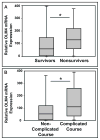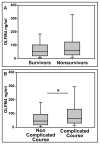Olfactomedin-4 Is a Candidate Marker for a Pathogenic Neutrophil Subset in Septic Shock
- PMID: 27635771
- PMCID: PMC5512699
- DOI: 10.1097/CCM.0000000000002102
Olfactomedin-4 Is a Candidate Marker for a Pathogenic Neutrophil Subset in Septic Shock
Abstract
Objectives: Heterogeneity in sepsis-related pathobiology presents a significant challenge. Resolving this heterogeneity presents an opportunity to understand pathobiology and improve patient care. Olfactomedin-4 is a neutrophil subset marker and may contribute to sepsis heterogeneity. Our objective was to evaluate the expression of olfactomedin-4 and characterize neutrophil heterogeneity in children with septic shock.
Design: Single-center, prospective cohort, as well as secondary analysis of existing transcriptomic and proteomic databases.
Setting: Tertiary care PICU.
Patients: Patients from 5 days to 18 years old with septic shock were enrolled. Data collected included the expression of olfactomedin-4 messenger RNA, serum protein concentrations, and percentage of neutrophils that express olfactomedin-4.
Interventions: None.
Measurements and main results: Secondary analysis of existing transcriptomic data demonstrated that olfactomedin-4 is the most highly expressed gene in nonsurvivors of pediatric septic shock, compared with survivors. Secondary analysis of an existing proteomic database corroborated these observations. In a prospectively enrolled cohort, we quantified the percentage of olfactomedin-4+ neutrophils in patients with septic shock. Patients with a complicated course, defined as greater than or equal to two organ failures at day 7 of septic shock or 28-day mortality, had a higher percentage of olfactomedin-4+ neutrophils, compared with those without a complicated course. By logistic regression, the percentage of olfactomedin-4+ neutrophils was independently associated with increased risk of a complicated course (odds ratio, 1.09; 95% CI, 1.01-1.17; p = 0.024).
Conclusions: Olfactomedin-4 identifies a subpopulation of neutrophils in patients with septic shock, and those with a high percentage of olfactomedin-4+ neutrophils are at higher risk for greater organ failure burden and death. Olfactomedin-4 might serve as a marker of a pathogenic neutrophil subset in patients with septic shock.
Conflict of interest statement
All authors report grant support from the NIH, no financial conflicts of interest.
Figures



References
-
- Martin GS, Mannino DM, Eaton S, et al. The epidemiology of sepsis in the United States from 1979 through 2000. The New England journal of medicine. 2003;348(16):1546–1554. - PubMed
-
- Watson RS, Carcillo JA, Linde-Zwirble WT, et al. The epidemiology of severe sepsis in children in the United States. American journal of respiratory and critical care medicine. 2003;167(5):695–701. - PubMed
-
- Zonneveld R, Molema G, Plotz FB. Analyzing Neutrophil Morphology, Mechanics, and Motility in Sepsis: Options and Challenges for Novel Bedside Technologies. Critical care medicine. 2016;44(1):218–228. - PubMed
MeSH terms
Substances
Grants and funding
LinkOut - more resources
Full Text Sources
Other Literature Sources
Molecular Biology Databases
Miscellaneous

